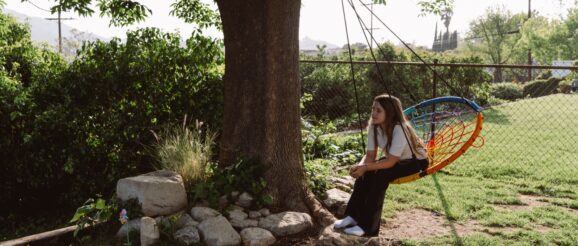After the LA fires, a camp helped kids find normalcy

Not long after the Eaton fire displaced her family from their Los Angeles home, 10-year-old Emory Stumme broke down. The tears came during a family dinner, and she struggled to catch her breath.
“You just were like, ‘I can’t pick up this fork, it’s too heavy,’ ” Emory’s mother, Becca, told her, recounting the episode. “You started crying and laughing and crying, and then heaving. I was like, ‘Oh my God, she’s really having a mental break.’ “

Becca Stumme, her husband and their two kids lost their Altadena home in the fire. Emory and her 3-year-old brother’s schools hit pause until they could relocate. When the Eaton and Palisades fires sparked in January — respectively the second- and third-most destructive in California history — familiarity, friend groups and routines were upset for Emory and many of her peers.


“By providing that sense of safety and normalcy at camp, we can help to lower their stress levels, return them to a routine, and only then can they start to create a narrative around what has happened … so that they understand that something has happened and that they’re safe now — to end that uncertainty and fear,” Latner said.


The program offered typical day camp activities such as arts and crafts, and games like tag. Other activities drew more directly from the camp’s trauma-informed approach. Mental health professionals were on site as volunteers to help address emotional issues that came up for kids.


The disruption of routines, community and familiarity by the wildfires have taken a toll on children’s mental health, said Kat O’Malley, an associate marriage and family therapist practicing in the Los Angeles area, who volunteered at the camp. Since the fires, she said, parents have reached out to her seeking therapy for their kids after noticing signs of emotional and physical distress tied to the tragedy. Some kids are experiencing an increase in panic or nightmares, are more prone to separation anxiety and mood swings, while others appear unaffected, according to O’Malley.
“Their sense of safety, stability — that was all rocked,” she said.
For kids who experience a natural disaster, O’Malley said, it helps to find some sense of normalcy to begin the healing process.

Becca said Emory’s time at the camp gave her daughter a chance to connect with friends while her school was paused.
“The first day that we picked her up from camp, I was like, ‘Oh this is the old kid again,’ ” Stumme said. “She was able to see her friends and be outside and play and just be a kid and not have to worry about, like, ‘Where are we staying tonight?’ or ‘What clothes do I have?’ “

Marah Eakin said sending her 6-year-old twins to the camp gave her some much-needed space to process her own feelings and handle “grown-up stuff,” like insurance paperwork.
The Eakin family has been bouncing from one short-term rental to another. The home they had rented in Altadena still stands, about 100 feet outside of the burn scar of the Eaton fire. But, while they work to get their landlord to clean the place of ash and potentially other toxic chemicals, she said it’s unclear if or when they’ll be able to return.

When Marah’s kids’ school resumed, not all of their classmates returned, the mother said. “A lot of their friends are scattered to the wind,” she said.
Her daughter Zella misses her stuffed animals that got left behind.
What might seem to some like an insignificant loss is often no small thing to a child struggling to cope with such losses, O’Malley said. Whether it’s stuffed animals or the family pet, the therapist said, kids grieve all kinds of things that might shape their sense of who they are.

“The biggest thing I think that comes up in grief work is when something changes your identity,” she said. “Oh, I have seven guinea pigs, six of them are hairless — that’s my fun fact — and one of my guinea pigs died last month, and I keep going, do I have to say six now instead of seven? It changes the way you introduce yourself, it changes so much about your identity, to have these shifts.”

“When somebody else goes, ‘Oh, this all happened for a reason’ — it’s not for someone else to tell you what your experience was,” she said. “That can be really diminishing. But when you yourself make meaning of an event, that can be very powerful.”
Often, the healing — sharing their feelings, telling their story — happens during the in-between moments, she said.
“You’re like, ‘Does anyone need to share?’ And people are like, ‘No, we want to get to lunch,’ ” O’Malley said. “And then on the way to lunch, somebody goes, ‘Oh wow, this reminds me of my kitchen that had this really beautiful tile in it, and I’m sad that tile’s gone. That was really meaningful to my family — Oh yay, hot dogs!’ “
